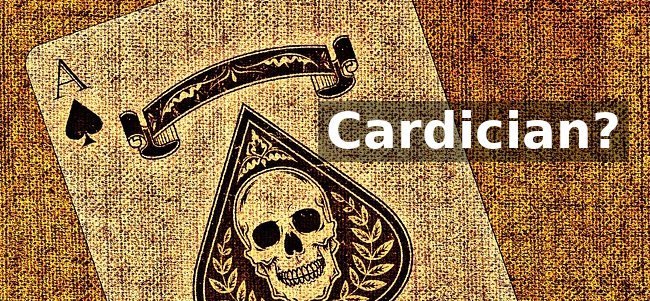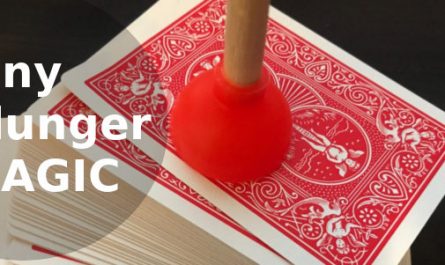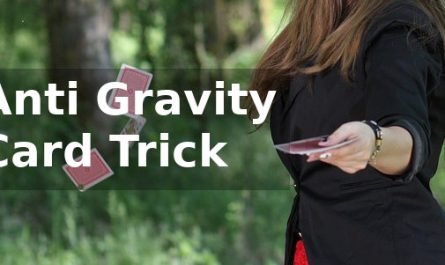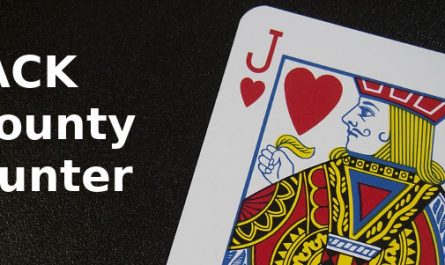Cardician Definition
So first of all answering the big question, what is a cardician? Well aside from being the name of a book by Ed Marlo; a cardician is also the title for a magician who performs card tricks. Obviously most people outside of the magic field will categorize all magicians as magicians regardless of the selective fields they may specialize in. Aside from being a cardician, some other specialties magicians may prioritize are escapology which includes a variety of different escape artists whether it be escaping hand cuffs or a tank filling with water. Illusionism, this field includes magicians who specialize creating illusions or utilizing them for most tricks in there performances. Lastly there are mnemonists who are able to use their incredible memory to pull off tricks.
How Can You Become a Cardician?
So you’ve delved into learning some basic magic tricks before or are brand new to magic and want to specialize in card tricks; so how do you become a cardician? Well first of all in order to be classified as master of card magic you must first determine the level that must be achieved in order for you to consider yourself a professional cardician. There is no preset qualifications that must be met in order to be a master magician in this field. If you asked every magician what qualifies someone to be called a cardician you would most likely receive a different answer each time. This is due to the aforementioned lack of set qualifications. Because of this prior to attempting to master this category of magic, goals should be set and a personal definition of what you must achieve to consider yourself a master of this craft should be established. Is there a certain location you want to be able to perform? or is there a certain amount of tricks that should be known? Personally I see a cardician as someone who is a true master of card tricks. They should be able to see any trick, live or on a video and know how its done and be able to reproduce it if given the same means.
Shuffling
The first thing you should develop when beginning to learn card magic or adding on prior knowledge is excellent sleight of hand. A card trick is immediately ruined the instant you drop a card or slip up when shuffling. The ease at which the deck is maneuvered is a pivotal part of almost any card trick. Showmanship is the biggest reason as to why sleight of hand is so important when it comes to card magic. Being able to have conversations and create dialogue whilst moving the deck at a fast pace makes a good trick great. It is important to understand that almost all card tricks feature a false shuffle. A false shuffle is when a deck appears to be shuffled fairly, however in reality it is put in a position desired by the magician. However even though the shuffling at play in most tricks isn’t legit, it’s still important to learn a few methods of shuffling to incorporate into the false shuffle in order to add to the tricks realism.
There are several different methods in shuffling a deck, some of the most common methods include the riffle shuffle, weave shuffle and the Mexican spiral.
Mexican Spiral Shuffle
The Mexican spiral shuffle isn’t a complex method of shuffling although it does show the deck being split. It does this in a way that intrigues those watching. This makes the method far better then simply halving the deck. The Mexican spiral shuffle is simply a series of circular motions where the top card is placed on the table, the new top card placed on the bottom and the following top card placed on the table and so forth. At speed this shuffle becomes hypnotic and an interesting thing to watch.
The Riffle Shuffle
The riffle shuffle has become an iconic part of many magic shows. In itself it is an interesting way to show an audience that a deck has been shuffled well. The riffle shuffle is a simple concept. It is simple the process of holding half the deck in either hand and loosing the grip on either hand as the two decks combine into one. Though this seems and sounds simple as many would know it is quite the opposite. This shuffling technique requires immense poise and sleight of hand. Many who have tried this shuffle will understand why these qualities are pivotal.
Failed attempts will become a regular occurrence at first to those practicing the shuffle. Cards are often bent in the process when the shuffle isn’t done to perfection. Additionally it is too easy to lose grip and drop cards. This obviously ruins a trick no matter how great it is. However when pulled off this form of shuffle is the perfect addition to any trick. For those interested in mastering technique here is a short 5 minute video on how to perform the riffle shuffle.
The Weave Shuffle
The weave shuffle is one of the most common forms of shuffling. Even though it doesn’t display tremendous showmanship, it does exude a sense of brilliant sleight of hand and cause the audience to view the deck as well shuffled. The weave shuffle is extremely simple. It is merely the act of pushing two halves of the deck together so that they smoothly intertwine with one another. This can be done at high speeds to add some further intrigue to the shuffle.
This shuffle is extremely simply although it is possible to make mistakes. Cards can often become stuck and hit one another in the process of shuffling. This then causes the shuffle to be halted and the deck potentially dropped or messed up.
Basic tricks
Now you have learnt some of the basic methods of shuffling to move forward with becoming a cardician you need to learn some basic tricks. Obviously more can be done to enhance persona and performance though and thus improve the show itself, however this can be worried about later on. For those brand new to card magic it is good to learn some basic tricks to impress the audience. As you advance though and learn more and more tricks and the tricks become far more complex there is a lot more that can be looked into.
As you begin to master tricks and establish a persona or character on show you can start to add and individual spin to things. This is a big step in actually becoming a cardician. A cardician should have tricks that are unique to themselves. Simply performing tricks done by other people isn’t enough to be classified as a true master of card magic. This is something to worry about in the future though once a basic understanding of some tricks is established.
Once this knowledge is absorbed though it is good to start thinking of ways to make tricks yours. Try to think about props that can be added to the mix. Or involving multiple people in the audience. This enhances the experience for everyone and adds to the mystery. Everyone knows magic is about making people ask how. Making them question how the illusion works and how it is possible. This feat is best done when people are left scratching their heads in disbelief. Moving on though lets look at some basic tricks
Those who truly thinking about trying to become cardicians should keep in mind what was said above though. It is good to start thinking about what you want to achieve early. The sooner you can start improving on and making tricks yours the better. This will become the only true way to advance in your path to be seen as a master of the deck.
Trick #1 The Tower Of Four
This trick is a great basic trick to learn for anyone new to card tricks. All the trick requires is for you to remember the fourth card in the deck when showing a shuffled deck to an audience member. As a whole to do the trick you must first get up a member of the crowd. Then shuffle the deck in front of them. Following this show them the deck and remember the fourth card going left to right on your side. Then shuffle the deck again and let them split the deck. Following this then say you can tell the fourth card on the other side by looking at the fourth card on your right side.
Proceed to take a sneak peak at the fourth card on your right and then tell them the fourth card on the left i.e the one you remembered at the beginning. For further explanation on this trick you can view this short 5 minute video.
This video provides a great demonstration of how to do this trick. Don’t be confused by the tremendous sleight of hand displayed in this video with riffle shuffling though. This trick can be done with any form of shuffle. Additionally this trick provides some great grounds to move forward with customization. There is a plethora of ways in which the trick can be altered to create entirely new and more entertaining tricks. All that must be kept is the principles.
Remember the key to this trick comes simply from remembering a card place when showing the crowd member a card. This aspect of the trick can be applied to create entire new tricks. It just takes some thought and creativity to build some intriguing tricks. Some ideas could be to customize the amount of cards down in the deck you remember. Or using the principle to have a crowd member choose a card which you can proceed to guess.
Trick #2 The Slop
This trick is a great trick to use at any show. Even without further customization the trick is intriguing and seemingly impossible. This trick utilizes the previously discussed false shuffle. The trick starts by obviously choosing a member of the audience to come up, Then shuffle the deck to show that it is in a random order. Next have the audience member choose any card from the deck. Following this the deck should be split approximately two thirds of the way down and the audience member asked to place there card back. Once the card is back in the deck the pinky finger should be placed on it to create a split in the deck. This end of the deck should be covered by your hands.
Following this the deck should be split as many times as you like but to the point where the crowd members card is on top. The deck should then be reshuffled but in a way in which the card chosen is placed at the bottom of the deck. A false sloppy shuffle should then be done to the deck by flipping a few cards up and the next few down until the deck is seemingly mixed up. But in this process the chosen card should be placed on top. The different ways the deck is mixed up should then be shown and once the back to back area is shown the deck half with the chosen card on top flipped.
Following this the cards can then be displayed and all cards should be facing down aside from the card that was selected which should be face up. This may seem complex from this description but after a visual demonstration and some practice it is clear to see that its quite simple.
This is a great trick to be learned as it shows great showmanship from the beginning. No further additions are needed for the trick to be interesting to perform. However this is what makes the trick so great. By adding more and more aspects to the trick it can only get better. All that must be remembered is the simple concept of the trick. This can then be stepped up and rehearsed to add intrigue. An example of this could be to wear a blindfold while performing the trick.
Not only does this addition in costume make the trick far more interesting but it also makes the shuffling look a lot more impressive. To be able to shuffle cards so uniformly whilst blind folded is a significant feat. This is just a suggestion though. With time you can come up with more and more ideas to better the trick and make it truly outstanding in a way that is impressive to even the harshest critics when it comes to magic.
Conclusion
In this we looked at what a cardician is. They are individuals who are truly masters of the deck. People who are able to perform and analyze tricks with little to no error. They show terrific showmanship and keep the audience both involved and intrigued in their performances. Shuffling is a big part of all card tricks. For this reason a cardician must have excellent sleight of hand.
They must be able to move the deck around with ease and shuffle it seamlessly. Finally we looked at some basic tricks that are great to learn for beginners. These tricks provide great background knowledge that can be used to create incredible tricks that are individual to the cardician.




